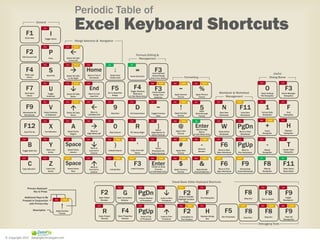

If you know the entire key sequence, go ahead, and use it. A notification pops up saying you're using an access key from an earlier version of Microsoft Office. For example, press Alt, and then press one of the old menu keys, for example, E (Edit), V (View), I (Insert), and so on.
EXCEL KEYBOARD SHORTCUTS 2013 EDITING FULL
However, you need to know the full shortcut. In Office 2013 and Office 2010, most of the old Alt key menu shortcuts still work, too. Both offer a largely similar experience, but some options and search results can vary. Press Alt again to see KeyTips for the options for the selected tab.ĭepending on the version of Office you are using, the Search text field at the top of the app window might be called Tell Me instead. For example, press Alt+H to open the Home tab, and Alt+Q to move to the Tell me or Search field. You can combine the Key Tips letters with the Alt key to make shortcuts called Access Keys for the ribbon options. Press the Alt key to display the ribbon shortcuts, called Key Tips, as letters in small images next to the tabs and options as shown in the image below. For example, on the Home tab, the Number group includes the Number Format option.

The ribbon groups related options on tabs. This table lists the most frequently used shortcuts in Excel. Keyboard shortcuts for refreshing external data Keyboard shortcuts for working with data, functions, and the formula bar Keyboard shortcuts for making selections and performing actions Keyboard shortcuts in the Paste Special dialog box in Excel 2013

Keyboard shortcuts for navigating in cells Get the Excel 2016 keyboard shortcuts in a Word document: Excel keyboard shortcuts and function keys. For instructions, go to Automate tasks with the Macro Recorder.ĭownload our 50 time-saving Excel shortcuts quick tips guide. If an action that you use often does not have a shortcut key, you can record a macro to create one. Press Ctrl+F, and then type your search words. You can also drag the scroll box for faster scrolling.To quickly find a shortcut in this article, you can use the Search. To scroll by a complete screen, click either side of the scrollbar’s scroll box(remember, it is not the arrow of the scrollbar, it is scroll box). To scroll one cell, click either of the arrows on the scrollbar. If your desired cell isn’t visible in the excel spreadsheet window, you can use the scrollbars to scroll the window in any direction to reach your desired cell. If you want to change the active cell by using your mouse, just click another cell, and it becomes now the active cell. *With Scroll Lock-on Navigating Excel worksheet with mouse Scrolls the screen right one column (active cell position is not changed) Scrolls the screen left one column (active cell position is not changed) Scrolls the screen down one row (active cell position is not changed) Scrolls the screen up by one row (active cell position is not changed) Scrolls the screen so that the active cell is visible Moves the active cell right by one screen Moves the active cell one column to the right Moves the active cell one column to the left Pg Up and Pg Dn move the active cell up or down one full window. The down arrow key moves the active cell down one row, the up arrow key moves the active cell one row, the right arrow moves the active cell one column to the right, and so on.

We shall use the standard navigational keys on our keyboard to move around a worksheet. Moving around the Excel Spreadsheet with your keyboard Row and column headings of the active cell appear in a different color to make it easier to identify the row and column of the active cell. If there were something in the active cell, it will be deleted if you enter something this way. If you have opened an existing spreadsheet, the active cell will be the last cell you selected before saving and closing the spreadsheet.Īctive cell means that it is active now if you enter something from your keyboard, it will accept. If you have created the spreadsheet just now, active cell will be A1 by default. When you open an Excel spreadsheet, you will find one cell is selected with darker borders. Commands to find the last cellįind the last row with this command: End →Down Arrow(↓), then find the last column with this command: End →Right Arrow(→), you will reach the last cell. The address of the last cell is XFD1048576. Highlighted Last Cell in an Excel Spreadsheet.


 0 kommentar(er)
0 kommentar(er)
